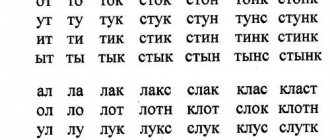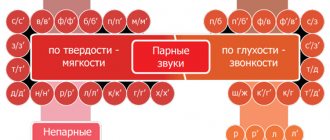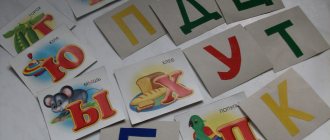4.2
Average rating: 4.2
Total ratings received: 471.
4.2
Average rating: 4.2
Total ratings received: 471.
All consonant sounds are divided into voiced and voiceless. In this article, intended for 1st grade students, we will consider voiced and unvoiced consonants: paired in voicedness/voicelessness, unpaired voiced and unpaired unvoiced.
Paired by voicedness/voicelessness
There are 21 consonant letters in the alphabet, which represent 37 consonant sounds.
Many consonant sounds form voiced/voiceless pairs. Such consonant sounds can be voiced or devoiced depending on their position in words.
All voiced consonant sounds consist of noise and voice, all voiceless consonant sounds consist only of noise.
Let's list paired consonant sounds by voicedness/voicelessness using the table “Voiceless/voiced consonant sounds”:
| Voiced consonants | Voiceless consonants |
| [b] | [P] |
| [V] | [f] |
| [G] | [To] |
| [d] | [T] |
| [h] | [With] |
| [and] | [w] |
The correct spelling of paired consonants based on voicedness/voicelessness is an orthogram that requires a test word.
Let us give examples: the word “tooth” is pronounced with a dull consonant sound [p] like [zup];
the word “teeth” is pronounced with a voiced consonant sound [b] like [teeth].
Hard and soft consonants.
Soft sounds differ from hard sounds in that when pronouncing them, the tongue performs an additional action: its middle part rises to the hard palate.
Consonants form 15 pairs according to softness/hardness:
| Doubles | unpaired (always voiced/voiceless) | |||||||||||||||||
| Solid | b | V | G | d | h | To | l | m | n | P | R | With | T | f | X | and | w | ts |
| Soft | b' | V' | G' | d' | z' | To' | l' | m' | n' | P' | R' | With' | T' | f' | X' | h' | sch' | th' |
Strong positions in hardness/softness:
- before vowels: nose - carried, they say [they say] - chalk [m'el];
- at the end of the word: chalk [m'el] - chalk [m'el'], blow - hit, corner - coal;
- for sounds [l], [l'] regardless of position: shelf [shelf] - polka [pol'ka];
- for sounds [s], [s'], [z], [z'], [t], [t'], [d], [d'], [n], [n'], [r] ,[p'] before [k], [k'], [g], [g'], [x], [x'], [b], [b'], [p], [p'] , [m], [m']: bank [bank] - bathhouse [ban'ka], blizzard [blizzard] - earring [ser'ga], hut - carving.
Weak position on hardness/softness:
- Changes in consonant sounds in hardness/softness can be caused by the influence of sounds on each other.
- the hard sound changes to a paired soft sound before soft consonants (usually z, s, n, p before any soft consonant): n –> n', p –> p' before ch', sh': drummer [drummer'sh'ik] , lamplighter [fanar'sch'ik];
- s –> s' before n', t': song [p'es'n'a], bone [kos't'];
- z –> z' before n', d': life [zhyz'n'], nails [nails'd'i];
- in some other combinations: door [d'v'er'], ate [s'y'el];
If dull and voiced sounds are indicated using letters, then hard and soft sounds are indicated by other means.
Indication of softness of paired consonants:
- with the letters I, E, E, Yu : lethargic - cf. val, ser - sir, drove - cart, hatch - bow;
- before the letter I, the consonants are always soft (except for Ж, Ш, Ц): fir, world, sieve; after Zh, Sh, Ts (they are always hard) it is pronounced [s], not [i]: fat [zhyr], zhito [zhyta], shishka [shishka].
- soft sign b : at the end of the word: stump, become - cf. camp, steel - became, heat - heat, reality - was, all - weight, stranded - chalk;
- softness of the consonant [l'] before any other consonant: herring, July, polka;
- the softness of a consonant standing before a hard consonant: before, only (cf. talk), bitterly (cf. slide), bathhouse (cf. bank), radish - rarely, zorka - zorko, pebble - jackdaw, coals - corners, hemp - foam ;
- The softness of a consonant that comes before other soft ones ([g'], [k'], [b'], [m']) is indicated by the soft sign b only if, when the word is changed, the second consonant becomes hard, but the first remains soft: earrings (soft [p'] before soft [g']) - earring (soft [p'] before hard [g]), eight - eighth, lights - lights. But, bridge [mos't'ik] – without b, because bridge [bridge] – [c] hard before hard [t], tail - tail, sprout - growth.
Hardness is indicated
- absence of a soft sign in strong positions,
- writing after the consonant the vowels A, O, U, Y, E
- in some borrowed words there is a hard consonant before E: phonetics [fanEt'ika].
What have we learned?
Many consonant sounds form pairs based on voicedness/voicelessness: [b] – [p], [v] – [f], [g] – [k], [d] – [t], [z] – [s], [g] – [w]. These consonant sounds can be voiced or voiced depending on their position in words. In the Russian language there are unpaired voiced consonants ([l], [m], [n], [r], [y]) and unpaired voiceless consonants ([x], [ts], [ch], [sch] ). Such consonant sounds do not have pairs for deafness (unpaired voiced consonants) or for voicing (unpaired voiceless consonants); their sound does not depend on their position in words.
What is it for?
The fact is that in the Russian language, letters denoting voiced consonants are not necessarily read voiced in all cases. There are also cases when letters denoting dull sounds are read loudly. The correct correlation of letters and sounds will significantly help in learning the rules of writing words.
Let us examine in more detail what the concepts of deafness and voicedness mean. The formation of voiced consonants occurs due to noise and voice: the air stream not only overcomes the obstacle in the oral cavity, but also vibrates the vocal cords.
- The following sounds are voiced: b, v, g, d, zh, z, l, m, n, r, y.
- However, in phonetics, from this series of sounds, so-called sonorant sounds are also distinguished, which are as close as possible in their characteristics to vowel sounds: they can be sung and prolonged in speech. These sounds include y, r, l, n, m.
Voiceless consonant sounds are pronounced without the participation of the voice, only with the help of noise, while the vocal cords are relaxed.
- These letters and sounds include the following: k, p, s, t, f, x, c, ch, sh, shch. In order to make it easier to remember all the voiceless consonants in the Russian language, you need to learn the phrase: “Styopka, do you want shchetc?” - “Fi!” All consonant sounds in it are unvoiced.
Extracurricular activities in Russian language
Advantageous options for developing interest in this area of science are evenings, competitions, and KVNs. They are held outside school hours for everyone.
It is very important to create an exciting scenario for such an event. Particular attention should be paid to designing activities that are both rewarding and fun. Such activities can be carried out with students of all ages.
Interesting tasks can also be those that contain an element of literary creativity. For example, it is useful to offer the guys:
- make up a story about how the sounds “t” and “d” quarreled;
- come up with as many words with the same root as possible for the word “horn” in one minute;
- write a short quatrain with rhymes: meadow-onion, twig-pond.
Why do you need to write voiceless and voiced consonants correctly in Russian?
Some people treat writing culture superficially. They justify their ignorance in this area with such a common phrase: “What difference does it make how it’s written, it’s still clear what it’s about!”
In fact, errors in spelling words indicate a low level of personal culture. You cannot consider yourself a developed person if you cannot write correctly in your native language.
There is one more fact that testifies in favor of the rule of error-free writing. After all, voiceless and voiced consonants are sometimes found in words that are homophones in oral speech. That is, they sound the same, but are written differently. Incorrect use of a letter in them is fraught with loss or change in the meaning of the context.
For example, the words “pond” - “rod”, “cat” - “code”, “horn” - “rock” are included in this list.
Hard and soft sound
Tones can be pronounced confidently or easily. They will be written identically, but spoken differently. Intonation is determined by the next vowel. Example: current - flowed, nose - carried.
If the sound is hard, the end of the tongue touches the palate; if the sound is soft, the middle of the tongue reaches the palate. Solids are pronounced:
- before the vowels A, O, U, E, Y;
- when there is a consonant after it;
- if the letter is at the end of the word;
- before E in words of foreign origin (for example, muffler, meringue);
- the letters Zh, Ch, C never soften, they are unpaired.
The sounds will always be soft before “ь”. But you can explain this to a child if he sees a written word. It's hard to tell by ear. They will also soften if they stand in front of I, Yu, E, Yo, I, for example, a ball, muesli, chalk, ice, rice. The letters Y, Ch, Shch are pronounced extremely softly: iodine, thicket. They do not form pairs. The table for the formation of hardness and softness is shown taking into account subsequent vowels.
| Solid | Before | Ma | Re | Zu | Would | That |
| Soft | Deux | Me | Re | Zyu | Bi | Those |
The following method can help you remember the softness of the sounds Y, Shch, Ch: when writing words with them, these letters need to be emphasized. This will symbolize the cushion on which the letter sits and seems to soften it.
The sounds [w], [zh], [ch'], [sh'] are called hissing, as they sound like hissing. Zh and Sh are classified as unpaired hard ones, Ch and Shch are classified as soft, not forming pairs. It doesn’t matter what vowels come after them, the first pair will still be read firmly, and the second one will be read softly, for example, went, pike. Even if you put a soft sign after Ж or Ш, they will remain hard. Although before the 14th century [zh] and [sh] were soft, this has changed in modern speech. Zh - voiced, Ch, Sh and Shch - voiceless.
These letters are pronounced in the same way, the lips are pulled forward a little and tensed. The tongue is not pressed completely against the palate. As a result, a gap should form through which air escapes, producing a hissing sound. It is said only while exhaling. If you close your lips, you won’t be able to make such sounds.
Sibilants are difficult for both adult and children's speech. To ensure that the child pronounces them correctly, tongue twisters are taught:
- Six little mice rustle in the reeds.
- Two puppies, cheek to cheek, were gnawing on a brush in the corner.
These sentences are spoken slowly at first, and then their pace is gradually accelerated.
After hissing words you should always write I, A, U. Y, Ya, Yu are not written.
Combinations of letters zch, zhch, zdch, sch are sometimes pronounced as [sch]: man - [man].
Didactic game “Connect the word being tested with the test word”
To get more done during class, you can play a game that reinforces skills without recording. Its condition will be a task in which children are asked only to connect test words with the trait being tested. It takes less time, and the work done will be extremely effective.
The game will become more interesting if it is played in the form of a competition. To do this, three variants of tasks are made, where two columns are used. One contains test words. In the other, you need to include those in which voiced and voiceless consonants are in a dubious position. Examples of words could be like this.
First column: bread, ponds, snow, onion, meadows, twig. Second column: onion, bread, meadow, twig, snow, pond.
To complicate the task, you can include in the column with test words those that are not suitable for testing, that is, they are not the same root as those whose spelling there are doubts: snacks, servant, octopus.
Shameful loss
During your Russian language lesson, you can tell schoolchildren a funny episode from your life. It should be based on the fact that several children did not know how to correctly write in words the letters denoting voiced and voiceless consonant sounds.
And this happened during the school team game “Treasure Hunters”. In its rules it was noted that it was necessary to move along the route indicated in the notes. Moreover, the place where the next letter was hidden was not indicated precisely. The note contained only a hint of him.
The teams received the first letters with the following text: “Road, meadow, stone.” One group of guys immediately ran towards the lawn and found a stone there, under which the letter was hidden. The second one, having mixed up the homophone words “meadow” and “onion”, ran to the garden bed. But, naturally, they did not find any stone among the bright green rows.
You can change history in such a way that the notes were written by an illiterate scribbler. It was he who, when giving instructions to his team members, used “bow” instead of the word “meadow”. Not knowing how to write paired voiced and voiceless consonants, the “literate” misled the children. As a result, the competition was canceled.








